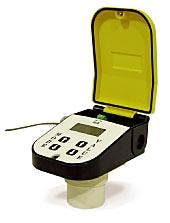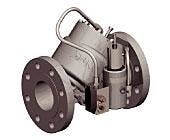New loop powered ultrasonic level sensor
Here's the new LPU-2127 loop powered ultrasonic level sensor, which is designed for continuous tank level measurement and environmental monitoring.
The maker says the unit's versatility, low maintenance, and noncontact operation help suit it for a variety of uses and harsh environments. The LPU-2127 is not affected by the color-translucency, dielectric constant, specific gravity, or viscosity of the target.
Additional features are:
Detection range of 1-25 ft for liquids.
Detection range of 1-10 ft for solids.
Integrated keypad and LCD display.
Loop-powered 4-20 ma output.
Easy installation.
Internal temperature compensation to accommodate for changes in ambient temperature.
Programmable filter to account for other application-specific variables.
Rugged transducer housing.
Source: Scientific Technologies Inc., Automation Products Group, 1025 W. 1700 N., Logan, UT 84321.
New products designed to help systems that monitor and control reciprocating compressors
Two new products recently introduced help upgrade and enhance the performance of the HydroCOM capacity control system for reciprocating compressors. HydroCOM uses hydraulic power and electronic time control to define the motion of compressor suction valves, resulting in stepless capacity control. The HydroCOM system provides a control range of 1-100%, from idling to full load.
HydroCOM-CCM is one of the new products: a lean, online monitoring system.
The HydroCOM-CCM monitoring system is powered by PROGNOST, the condition and performance monitoring system for reciprocating compressors already equipped with a HydroCOM control system, or where a retrofit is intended. There is also a PROGNOST monitoring system available for those compressors not equipped with HydroCOM.
The other recently introduced product— HydroCOM ROD position analyzer—provides continuous monitoring of rider ring conditions. The analyzer can measure and analyze the piston rod position over 360°, making it possible accurately to determine precisely when rider rings need replacement. The analyzer uses the same electronic platform as the HydroCOM control system. Additionally, it can be fully integrated into either the HydroCOM-CCM or PROGNOST-CCM online monitoring systems.
Source: Hoerbiger Corp. of America Inc., 3350 Gateway Drive, Pompano Beach, FL 33069.
New control valve
New Model BV60 control valves are back pressure regulators designed to maintain a specific minimum upstream pressure regardless of fluctuations in flow rate or downstream pressure.
When correctly installed and adjusted, the valve will maintain upstream pressure at a value within 5 psi of its pilot's setting. A minimum pressure differential across the valve of 15 psi is required for it to open fully.
The valve features:
Modular construction. All internal parts including seat ring can be removed with the cylinder assembly without disturbing line connections.
No diaphragms or stuffing boxes.
45° body design that helps assure high capacity.
Positive shutoff.
Uniform speed of response.
Linear control characteristics.
Inherently checks reverse flow.
O-ring plus metal-metal seat.
Tapered ports for better low flow response.
Source: Brodie Meter Co. LLC, 19267 Highway 301 North (30461), Statesboro, GA 30459-0450.
New three piece ball valve
The new Xtreme seated, Fire-Tite ball valve is suited for handling petroleum products and other flammable or hazardous substances.
The standard three piece valve is fire-test approved to API-607, Edition 4 and conforms to ANSI B16.34/B31.3. Seat material is a proprietary filled fluorocarbon.
The valve's flexible lip seat helps ensure that, under pressure, the ball will migrate towards the downstream seat. The lip seal allows the seat to deflect without permanent deformation so it returns to its original shape and seals bubbletight. The support zone cradles the ball just like a bearing, so wear and abrasion events are concentrated there. The sealing zone at the flexible lip is independent from the support zone, helping ensure longer life, tight shutoff, and process efficiency, the company says.
Source: Lokring Technology Corp., 960 Gateway Drive, Burlington, Ont. L7L 5K7.




